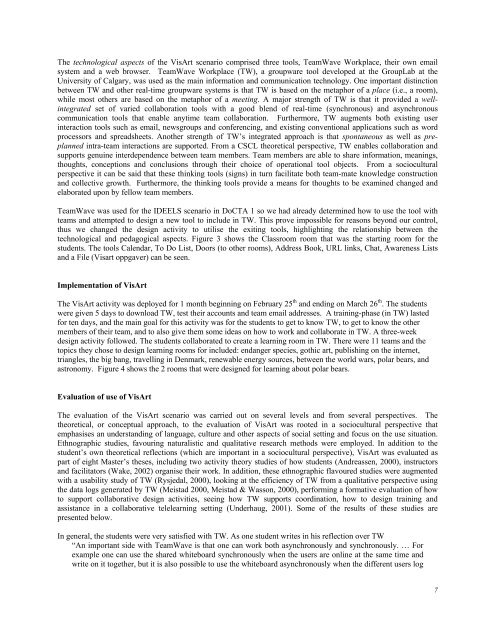October 2007 Volume 10 Number 4 - Educational Technology ...
October 2007 Volume 10 Number 4 - Educational Technology ...
October 2007 Volume 10 Number 4 - Educational Technology ...
Create successful ePaper yourself
Turn your PDF publications into a flip-book with our unique Google optimized e-Paper software.
The technological aspects of the VisArt scenario comprised three tools, TeamWave Workplace, their own email<br />
system and a web browser. TeamWave Workplace (TW), a groupware tool developed at the GroupLab at the<br />
University of Calgary, was used as the main information and communication technology. One important distinction<br />
between TW and other real-time groupware systems is that TW is based on the metaphor of a place (i.e., a room),<br />
while most others are based on the metaphor of a meeting. A major strength of TW is that it provided a wellintegrated<br />
set of varied collaboration tools with a good blend of real-time (synchronous) and asynchronous<br />
communication tools that enable anytime team collaboration. Furthermore, TW augments both existing user<br />
interaction tools such as email, newsgroups and conferencing, and existing conventional applications such as word<br />
processors and spreadsheets. Another strength of TW’s integrated approach is that spontaneous as well as preplanned<br />
intra-team interactions are supported. From a CSCL theoretical perspective, TW enables collaboration and<br />
supports genuine interdependence between team members. Team members are able to share information, meanings,<br />
thoughts, conceptions and conclusions through their choice of operational tool objects. From a sociocultural<br />
perspective it can be said that these thinking tools (signs) in turn facilitate both team-mate knowledge construction<br />
and collective growth. Furthermore, the thinking tools provide a means for thoughts to be examined changed and<br />
elaborated upon by fellow team members.<br />
TeamWave was used for the IDEELS scenario in DoCTA 1 so we had already determined how to use the tool with<br />
teams and attempted to design a new tool to include in TW. This prove impossible for reasons beyond our control,<br />
thus we changed the design activity to utilise the exiting tools, highlighting the relationship between the<br />
technological and pedagogical aspects. Figure 3 shows the Classroom room that was the starting room for the<br />
students. The tools Calendar, To Do List, Doors (to other rooms), Address Book, URL links, Chat, Awareness Lists<br />
and a File (Visart oppgaver) can be seen.<br />
Implementation of VisArt<br />
The VisArt activity was deployed for 1 month beginning on February 25 th and ending on March 26 th . The students<br />
were given 5 days to download TW, test their accounts and team email addresses. A training-phase (in TW) lasted<br />
for ten days, and the main goal for this activity was for the students to get to know TW, to get to know the other<br />
members of their team, and to also give them some ideas on how to work and collaborate in TW. A three-week<br />
design activity followed. The students collaborated to create a learning room in TW. There were 11 teams and the<br />
topics they chose to design learning rooms for included: endanger species, gothic art, publishing on the internet,<br />
triangles, the big bang, travelling in Denmark, renewable energy sources, between the world wars, polar bears, and<br />
astronomy. Figure 4 shows the 2 rooms that were designed for learning about polar bears.<br />
Evaluation of use of VisArt<br />
The evaluation of the VisArt scenario was carried out on several levels and from several perspectives. The<br />
theoretical, or conceptual approach, to the evaluation of VisArt was rooted in a sociocultural perspective that<br />
emphasises an understanding of language, culture and other aspects of social setting and focus on the use situation.<br />
Ethnographic studies, favouring naturalistic and qualitative research methods were employed. In addition to the<br />
student’s own theoretical reflections (which are important in a sociocultural perspective), VisArt was evaluated as<br />
part of eight Master’s theses, including two activity theory studies of how students (Andreassen, 2000), instructors<br />
and facilitators (Wake, 2002) organise their work. In addition, these ethnographic flavoured studies were augmented<br />
with a usability study of TW (Rysjedal, 2000), looking at the efficiency of TW from a qualitative perspective using<br />
the data logs generated by TW (Meistad 2000, Meistad & Wasson, 2000), performing a formative evaluation of how<br />
to support collaborative design activities, seeing how TW supports coordination, how to design training and<br />
assistance in a collaborative telelearning setting (Underhaug, 2001). Some of the results of these studies are<br />
presented below.<br />
In general, the students were very satisfied with TW. As one student writes in his reflection over TW<br />
“An important side with TeamWave is that one can work both asynchronously and synchronously. … For<br />
example one can use the shared whiteboard synchronously when the users are online at the same time and<br />
write on it together, but it is also possible to use the whiteboard asynchronously when the different users log<br />
7

















